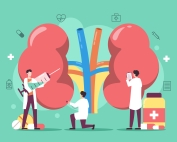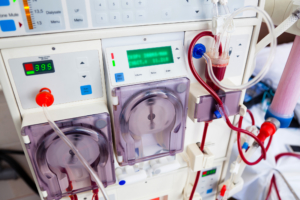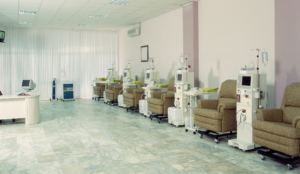Hemodialysis
 Most people on hemodialysis go to a dialysis center for treatment, but home hemodialysis is becoming more popular. Home hemodialysis (HHD) occurs in one’s home where you are the one doing the treatment and you decide the timing of your treatments. You may or may not need a partner to help you with it. Many dialysis staff and physicians say that they would choose home dialysis if they discovered they had ESRD. Medicare also encourages people to do home dialysis.
Most people on hemodialysis go to a dialysis center for treatment, but home hemodialysis is becoming more popular. Home hemodialysis (HHD) occurs in one’s home where you are the one doing the treatment and you decide the timing of your treatments. You may or may not need a partner to help you with it. Many dialysis staff and physicians say that they would choose home dialysis if they discovered they had ESRD. Medicare also encourages people to do home dialysis.
Since the early days of dialysis, doctors quickly learned that 1-2 treatments per week did not clean the blood well enough. Many patients seemed to do well with a treatment schedule of three times per week, so that was set as the established regimen. However, we have known since the 1980’s that the mortality rate of dialysis patients is high. Recent studies have suggested that more frequent and longer treatments may offer significant benefits to health and well being.
In order to provide treatments more often or for longer time periods, patients have to be cared for in a different way. A “one-size fits all” treatment system does not work for many people and may cause complications such as heart disease.
Worldwide, very few in-center dialysis patients receive treatments five or more times per week, even though reports show that patients receiving more frequent dialysis experience fewer deaths and improved health. Dialysis center schedules are set to do treatments three times per week. As a result, it is generally much easier to schedule more frequent treatments at home (short daily hemodialysis) and thus do home dialysis.
Daily Home Hemodialysis
Daily home hemodialysis (HHD) is not for everyone. It requires both a patient and partner who are committed to being trained on and following the guidelines for proper system operation.
If you choose to do daily home hemodialysis you must carefully follow your dialysis prescription, which may call for daily treatments up to six times per week. Each treatment can take about 2.5-3 hours or more including set up and tear down.
To be successful with home hemodialysis you must make sure you have a clean and safe place to do your treatments. You will also need to have space set aside in your home to store your supplies.
You and your partner will be responsible for tasks that would normally be taken care of by the in-center dialysis staff. You will perform all of the dialysis treatment tasks from start to finish, including setting up the machine and tubing, inserting the needles, responding to and solving all system alarms, and doing all of the clean up at the end of treatment. You will learn how to take your blood pressure, follow infection control procedures and how to follow the step by step instructions given to you by your training nurses. You and your partner will also be trained to respond to any health emergencies that might happen during treatment at home, including dizziness, nausea, hypotension (low blood pressure), and fluid or blood leaks.
Thousands of patients are performing daily HHD and enjoy the improved health, quality of life and freedom it provides.
Benefits of Home Hemodialysis:
- A significantly lower risk of death.
- Reduced stress on the heart caused by fluid buildup.
- Significant, lasting improvement in symptoms of depression.
- An 85% improvement in the time it takes to “recover” after each treatment, from nearly nine hours to about one hour, on average.
- Fewer problems with high blood pressure, putting less strain on the body and heart. Many patients and doctors report being able to cut down or eliminate the amount of medicines needed.
- Improvement in health-related quality of life scores, including physical and mental functioning.
- May Improve sexual desire and intimacy
- Improved appetite with fewer fluid and dietary limits.
- Increase in energy and vitality so that patients can go back to work and take care of their families.
Quality of Life Benefits of More Frequent Home Hemodialysis:
- Due to the shorter post-treatment recovery time patients may gain a day or more of quality time per week.
- More control, freedom and flexibility with treatment scheduling. This means patients can fit dialysis into their lives, rather than fitting their life around treatment.
- Ability to travel without having to schedule in-center treatments along your route, with newer, portable machines.

























